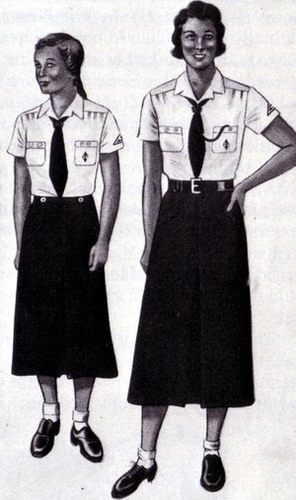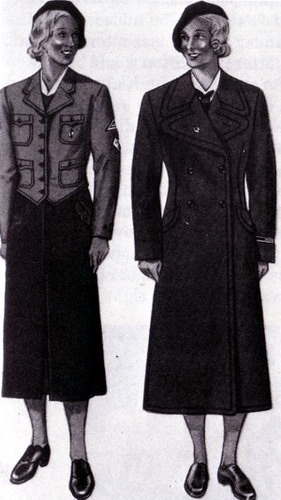The uniform of the League of German Girls is called the Bundestracht, which literally means national traditional uniform. This is the basic uniform you will need to have for your BDM impression. Make sure to check the section about purchasing your kit.
Girls weren’t issued their uniforms like soldiers were but rather had to purchase the regulation uniforms, or, if they couldn’t afford them, had to make them themselves using approved patterns and fabrics. Patterns were sold by a number of different manufacturers, such as ABC Schnitt or Der Goldene Schnitt, and department stores sold approved fabrics. Sometimes girls who were new – especially younger girls – wore items that looked similar to the uniform at first. But girls felt pressure to get the “real thing” – one former member said that her homemade uniform didn’t look exactly like the regulation ones and because of this, she always had to stand in the center during formations so that she wouldn’t stand out too much.
We see a number of different styles of blouses and sometimes different styles of skirts. This comes in useful for your impression, too, because if you’re not too sure that you want to really get into re-enacting, or you can’t afford to drop $250 on a reproduction jacket alone, you can start off with a plain white blouse and dark blue skirt and then buy other pieces bit by bit. A word of caution, however – if you go this route, please make sure that all of your substitute items are correct for the time period – in other words, if it looks or feels like polyester or is a miniskirt, don’t wear it.
 The Summer Uniform
The Summer Uniform
The basic summer uniform that you can see in the period drawing on the right consisted of a white blouse, dark blue skirt, and black neckerchief.
All accessories and insignia that were worn with and on the uniform are talked about in other sections of this page.
→ Blouse
The white blouse worn in summer was a short-sleeved blouse with a collar that was designed to be worn folded down and two chest pockets, each of which closed with two buttons. A different style with a pocket flap that closed with one button was also known.
The blouse was designed with a neck yoke to give it a smart fit around the shoulders, and from there the parts below had pleats so that the blouse allowed for a lot of movement.
The blouse should be made from a shirting cotton, worsted cotton, or poplin, and was often worn over the sports shirt or a white undershirt.
Remember that this uniform was designed to be comfortable and to be worn hiking and camping, so it should fit you accordingly.
→ Skirt
The skirt was a very dark blue, almost black color, and closed with either snaps, buttons or a metal zipper on the left side. Back zippers or plastic zippers weren’t used during this time period. The skirt had center pleat in the front to allow for movement because the uniform was worn on hikes, while riding bicycles, and around camp. Some versions also had small kick pleats on the side.
Skirt lengths varied over the years with the fashions and ranged from mid-calf length to just a little above knee length. Skirts that came to just below the knees were the most common style and are seen in most of the photographs. Shorter styles that ended above the knees are usually only seen on younger girls and shouldn’t be worn by anyone over fourteen at an event.
Your skirt should be made from a lightweight wool or a period correct wool blend, such as wool and rayon. Polyester is never correct for this time period. It should be light enough to be worn in summer but heavy enough to be worn during the colder months as well. Because the skirt doesn’t have a liner of any kind, you should wear a slip underneath – or your sports shorts, whichever you prefer.
Younger girls’ skirts had button holes along the waist in order to button the blouse into the skirt. This was done so that skirts weren’t tight or constricting around a girl’s waist and to allow for free movement. Older girls wore a dark blue or black leather belt with an open silver-colored buckle. All skirts had two small covered pockets on the front.
→ Neckerchief
Worn with the uniform was a black neckerchief called the Fahrtentuch, which was identical to those of the male Hitler Youth. The neckerchief was made of a somewhat shiny, lightweight, brushed cotton material. They were rolled up to the size of a tie so that only a small black triangle showed under the collar in the back. It was worn underneath the collar around the neck and fastened with a woven leather slide at the front. If the neckerchief was long enough, it was worn tucked into the waist of the skirt in order to keep it out of the way.
Just like boy scout neckerchiefs, the BDM’s neckerchiefs were used in first aid training and to render first aid if it was necessary. Therefore, the neckerchief needs to be fairly large – the size of a modern triangle bandage found in most first aid kits is a very good indicator of the correct size needed.
→ Leather Slide
The leather slide worn to hold the neckerchief at the front was made from a long piece of smooth leather lace and the knot is called a Turk’s Head Knot. The colors of these varied from a very light brown to a very dark brown, and if you are planning to make your own, you don’t have to go looking for the “right” color of leather lace. You will need approximately two yards to make a knot.
 The Winter Uniform
The Winter Uniform
The basic winter uniform that you can see in the period drawing on the right consisted of the summer uniform (often worn with a long- sleeve blouse instead of the summer short-sleeve one) with the addition of a short brown jacket, a brown greatcoat, and a black wool beret. All accessories and insignia worn are described in their respective sections.
→ Climbing Jacket
The short jacket is called a Kletterjacke, or climbing jacket – this name probably originated in the jackets similar to those worn by mountain climbers during that time period. It was worn mainly in spring and fall when it was too cold to go without a jacket, and also in high winter with or without an overcoat over it.
The jacket was designed to be comfortable and to allow a lot of motion, but at the same time was very form-fitting. It was made from a light brown (fawn) colored suedette fabric, which is a faux suede similar to velour. Nowadays, suedette is most often used as an upholstery fabric. Colors varied from a more pale greyish brown to a darker more orangish brown.
The climbing jacket usually had a liner, though not all of the homemade ones did. Jacket liners varied from light brown cotton material to a green or purple rayon. Especially jackets made later during the war usually had a rayon lining because rayon was domestically produced whereas cotton had to be imported. Sometimes jackets also had inside pockets to keep their wallet in.
The jacket had four covered pockets on the front that buttoned with one button each, and pocket styles were either plain as seen in the drawing on the right, or with a pleat in the center. The back of the jacket had two small take-up tabs to take in the waist if there was need.
→ Greatcoat
I haven’t really seen the greatcoat worn in photos because girls generally only wore their Kletterjacke and a wool sweater underneath, or wore a civilian overcoat with their uniforms. It is perfectly correct for you to have a civilian overcoat that is correct for the time period to wear at events. The issue overcoat was made from heavy brown wool and was worn with a cufftitle on the left sleeve instead of the Gau triangle like other uniforms.


